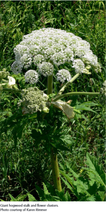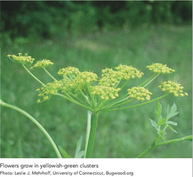 Giant Hogweed The stems and leaves of this plant are covered with small hairs coated with poisonous sap. Even the slightest touch can cause painful blisters and severe skin irritation. The symptoms can take a couple of days to develop with the skin becoming highly photosensitive producing large watery blisters; however the effects can be long lasting, with contact resulting in recurrent dermatitis. This is a particular concern for small children who may use the stems as pea-shooters or pretend telescopes resulting in horrific injuries. What does Hogweed Look Like?
 Wild Parsnip Is another weed that should also be avoided. The effects are similar to those associated with Giant Hog Weed. Irritation can occur if your skin contacts the plant’s fluids and is then exposed to sunlight. Contact with the eyes can cause temporary blindness and in rare cases permanent blindness. Wild parsnip can be found within uncultivated land, roadside ditches, parklands, nature trails and sports fields as well as on and around residential properties. What Does Wild Parsnip Look Like?
Being able to readily identify wild parsnip and giant hogweed will minimize accidental exposure to these plants and the painful results that follow. Anyone having information on specific locations where these weeds are posing a public risk should contact the Invading Species Hotline at 1-800-563-7711. You will be asked to send in photos for identification. DO NOT touch, cut or collect parts of the plant. The Temagami Medical Centre and Family Health Team ... committed to keeping you as healthy as possible! DID YOU KNOW…
The good news is that falling can be prevented! FOUR THINGS YOU CAN DO TO PREVENT FALLS:
The Temagami Family Health Team will be hosting another 12-week Stand Up Program starting in August. If you are interested in attending or know someone who could benefit, please call the office at )705) 569-3244 to register. Space is limited so register early! Many falls can be prevented.
By making some simple changes, you can lower your risk. Spirometry is a common and effective diagnostic test that can easily be done in your health care provider’s office. Spirometry is the most reliable way to test your lungs for COPD (chronic obstructive pulmonary disease) and asthma. The earlier it’s done, the earlier lung disease can be detected and treated. Who should have spirometry testing? People with asthma: Spirometry is an important diagnosis and management tool for people with asthma. If you have asthma and have never had a spirometry test, please talk to our respiratory therapist about spirometry. Smokers and former smokers: If you are over 40 and smoke or used to smoke, you may have COPD. Take this quick test:
If you answered "Yes" to one or more of these questions, you may have symptoms of COPD. See our respiratory therapist to find out what is causing your symptoms Why should I see a respiratory therapist? Can't it wait? If you get early treatment for COPD you can slow down the damage to your lungs. Referrals to our respiratory therapist are generated through the Temagami FHT’s physician, nurse practitioner, registered nurse or through self-referral by calling (705) 569-3244 to request an appointment. Early detection and intervention contribute
to the best possible health outcomes! Fast Facts:
Stroke Can Happen at any Age Although stroke is most common in people over the age of 70, the new data, according to the Canadian Heart and Stroke Foundation, reveals an alarming increase among those under 70. Over the past ten years, strokes in people in their 50s have increased by 24 per cent and, in those in their 60s, by 13 per cent. Even more troubling, recent international studies predict that stroke rates among younger people (ages 24–64), will double in the next 15 years. What are the Five Signs of Stroke?
Stroke is a medical emergency and every minute counts. Anyone who witnesses or experiences the signs of a stroke should call 9-1-1 immediately so the person can get to a hospital that is equipped to provide emergency stroke care. The sooner someone who is experiencing stroke gets to hospital and receives appropriate treatment, the better their chances of recovery. Prevention every step of the way There is hope -- stroke is treatable and preventable. Up to 80 per cent of premature heart disease and stroke can be prevented. It’s never too late to adopt healthy behaviours that will decrease your risk factors for stroke, even after a stroke has occurred. Go to https://ehealth.heartandstroke.ca/heartstroke/hsra to take the Heart and Stroke Risk Assessment and get tips on how to maintain healthy changes. If you are a rostered patient and do not have access to a computer, feel free to call the office at (705) 569-3244 to make an appointment with our dietitian who can take you through the risk assessment. Preventative Health Care – the Easiest Way to Protect Your Future! |
AuthorEllen Ibey Archives
August 2022
Categories
All
|
Temagami Medical Centre and Family Health Team provides quality inter-disciplinary health care to Temagami and area.
Patient SurveyIf you're a Temagami FHT patient, we want to hear your input! Click below to fill out our Patient Experience Survey. |
What's New?There's always something going on at the Temagami FHT. Check out our calendar for up-to-date events, and click below for our news page, updated weekly with the latest tips and information!
|
Further information |
About |
Programs |
|

 RSS Feed
RSS Feed
